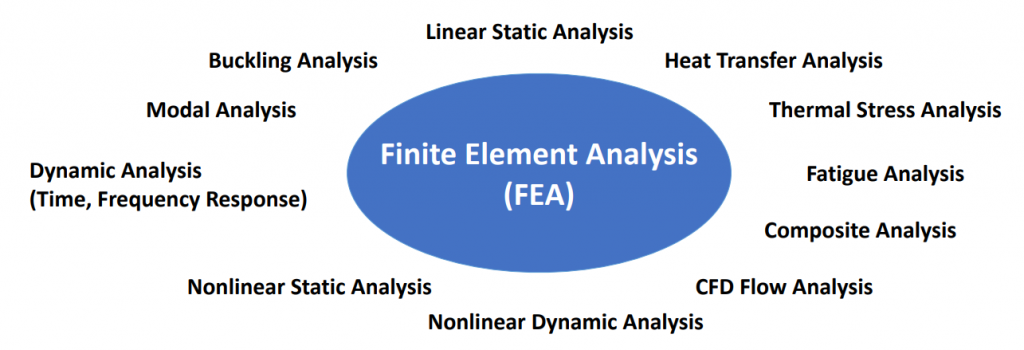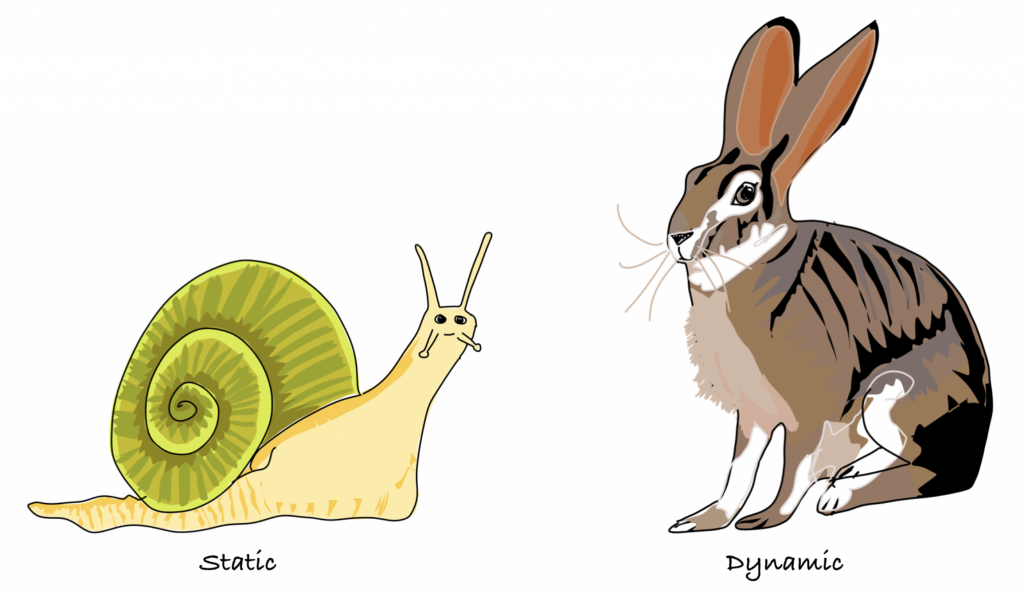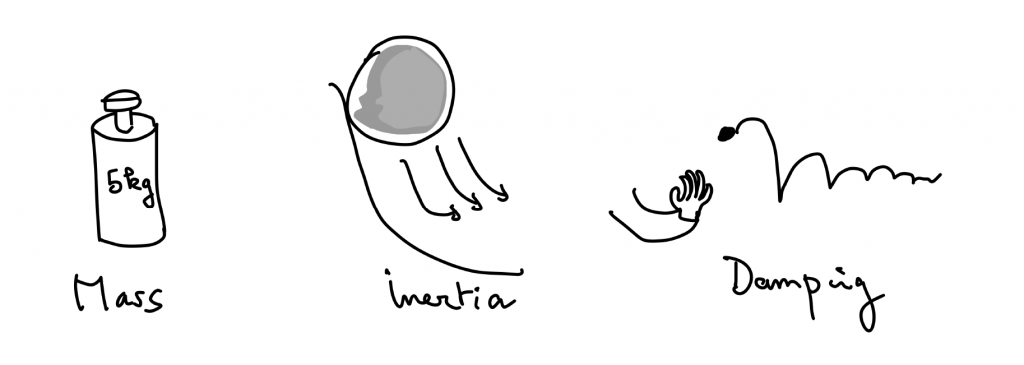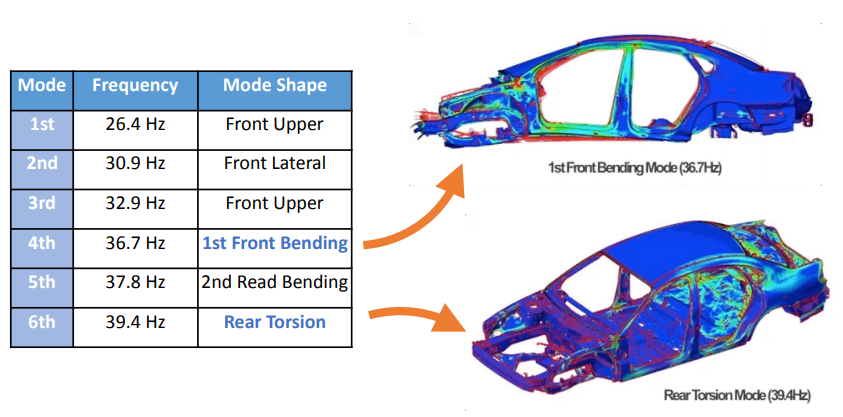Cyprien here, In today’s video we’ll talk about modal analysis and FEA Simulation!
That’s a topic which is pretty basic in FEA. If you’re doing Finite Element Analysis, you have to know what is Modal Simulation.
And still, I always get a lot of question about what is Modal Simulation, how do you use it and why? …
I’ve written a few blog posts about it and a lot of people came back to me and told me that this was so useful, so I decided to make a video to convey my understanding of modal analysis in a more accessible form!
I hope you like this new format because it’s really, really important to understand what modal analysis is.
Okay, so let’s start. So in FEA you have several types of simulations:

And you can separate all of them in 2 main categories: static simulations and dynamic simulations (I am simplifying):

If you suppose that the system doesn’t move, it’s fixed and the simulation is static.
In a dynamic simulation, your system moves dynamically and there is an influence of this movement on the behavior of the system.

And generally, the dynamic influence is due to several factors. So the inertia, the mass of the system, and the damping.

So those three are the most impactful dynamic factors you can say.
Now, why would you have to understand this?
Well, a system which is static and doesn’t move can be correctly designed in its static state, but as soon as it starts to move, mass, inertia, damping enter into play and the system might break under a sudden load applied to it, or simply the system can be put into conditions that are not ideal for it.
Check the following blog posts for more details:
Now, back to modal simulation, why do we use this type of simulation? Well, it’s basically an entry-level type of simulation to go into the dynamic realm. So, it’s classified as a dynamic simulation because it helps to determine the vibration modes of your system.

And then you’ll have to perform more advanced simulation to understand how the model actually vibrates along to those modes.
Now you have to understand what the vibration modes are. And for that, I have a few very simple examples that I always give. Think about your car and when you’re driving in normal condition, you’re not going too fast. If you have a good car, you don’t feel too much the vibration of the engine, right? So, but as soon as you go faster, you start to feel this vibration. Suddenly you feel this all your car start to shake.
And this is because the speed you’re driving at has carries some vibration, also the road is not perfect, and you’ll have the influence of very small deformation on the road, on your engine. And the speed you drive in causes the vibration at a certain frequency happening into your system. And when your typical car is loaded at this typical frequency, your system starts to behave in a dynamic way, and your motor, your engines start to vibrate in a very, let’s say, not the typical small deformations, it starts to increase a bit the displacement, and this is due to a phenomenon called resonance into mechanical system is that every system has a certain set of very important vibration called resonance vibration, which will drive the system into a resonance state, which means that the displacement normally happening will increase suddenly exponentially at a very specific frequency.

So of course you don’t want that to happen because it means that if you stay in this very specific frequency, your system will break. So it will cause a lot of damage into your system. So what generally engineers wants to do is to design a system so that it never goes into those forbidden resonance frequencies. So you stay in between those frequencies and you stay in the safe operating mode. So modal analysis gives you all the values of those resonance frequencies into your system. Now, what is important to understand also is that it gives you only the value of the frequencies, but it does not tell you how much your system behaves or deforms at this specific frequency, it only tells you what is the vibration frequency.

It doesn’t tell you how much your model will deform. So, I’m repeating that because it’s really important. And some people, they use FEA software, they get those frequency, they look at the different shape, and then they’re starting to think, Oh, okay, that’s how my system deforms. And they look at the value and they note it and, Okay, that’s it, I’ve got my maximum deformation at this frequency. No, modal deformation only gives you frequency and idea of how it deforms, so that’s called a mode shape, but it doesn’t give you the actual value of the deformations. So even if you see a certain value inside your software, generally this is a fake value used just for purpose of visualization. So don’t confound that with something real, and this is real deformation of my model, no. And this is also why, because when you do a modal analysis, you only apply constraint condition, you do not apply loadings.
So there’s no loading in the modal simulation. There is no force acting at a specific frequency applied, there is only restraint on the model. So you are able to view the vibration of your model at this frequency, but that’s all. And, another thing, so what do you do when you actually want to know the actual deformation? Well, you have to use a more complex type of simulation. So for example, frequency response simulation is basically used to analyze the actual response of the system on a certain frequency. So, and then you’re allowed to apply a real dynamic load to your system and see how it behaves. And the results you get is the real deformation of your system. Now, of course, if your model is set up correctly.

Now, is it the only important thing about modal analysis?
No, modal analysis can be useful in other contexts. So, one reason I like modal analysis is that it allows me to check also my model, because there is something about modal analysis that is called rigid body modes. And this is basically something that happens on your model if it is not constrained correctly. If you have a boundary condition which is not applied correctly to your model, and it’s supposed to move in one direction infinitely because it’s not constrained correctly, and this is called a rigid body mode. And when you do a modal simulation, you actually see that generally in the software, or you see a very huge deformations in one direction and then you know, Oh, there is a rigid body mode and that means that I didn’t constrain correctly:

Why is it important to do a model to do that?
Because generally when you do a linear static simulation, it doesn’t tell you this information, it just tells you your simulation fail because you have a singularity or you have a degree of freedom, which is not correctly constrained at this point. But it doesn’t tell you exactly which constraint’s not correct, why it’s not working, and sometime it’s due to the contacts inside the model, so it’s much more insidious to understand which contact is actually failing. But if you do a modal analysis, you see it immediately, you see that, Oh, okay, so there is a big displacement between those two parts. Why is that? I put a contact, but it doesn’t work. So, modal analysis can help you to see this kind of things as well. So it’s a very good tool to check your results, make sure that your simulation is okay.
To understand more about modal analysis, read these articles:
Okay, so that’s all for today’s rant. I could go on and tell you much more about this topic, but please, if you want to know more, go back on the blog and read those articles, I’ll put the link below the video. And if you want to know more about one specific aspect of engineering, if it’s element simulation or CAE, just let me know in the comments. I read everything, and I try to respond as much as I can. Thank you for reading my blog!
Cyprien “Modal in Video” Rusu

Thanks, for this advance level information in addition to your previous MODAL ANALYSIS blog
Hi Cyprien,
I have not seen a video for Salome installed in windows with Aster-wizard or aster-study for stress analysis.
what tools are you using for stress analysis in salome 9.5 to current release?
Thanks
Martin
Is there any thread where you have explained the difference between max.principle stress and von misses stress?
Hello Cyprien,
Thank you for the clear and concise explainations. I am new to the FEA area. I have found your video when looking for what is modal analysis. I am happy to find your videos and blog.
Kind regards.
Thank you!
Hello Cyprien thanks a lot, can you please explain on modal participation factors.